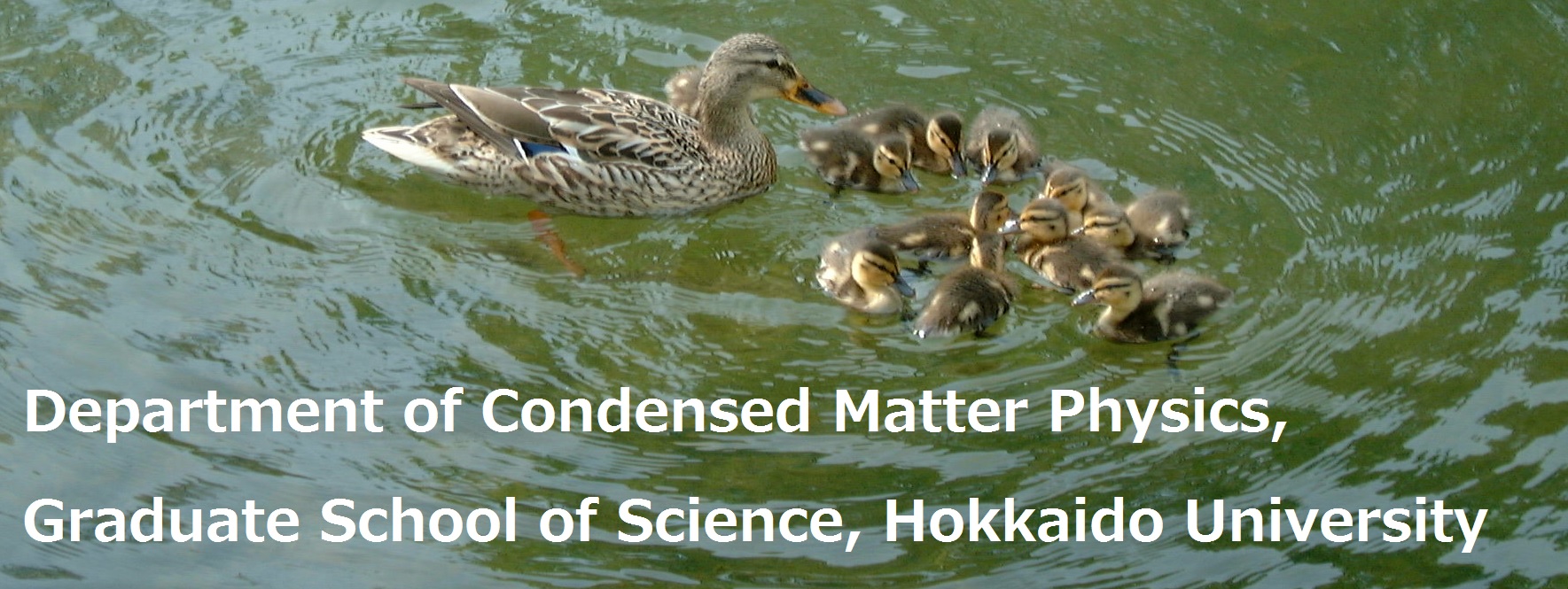|
|
 |
Research Areas
|
|
Laboratories
|
Position
|
Supervisors
|
Keywords
|
|
Statistical Physics
|
Professor
Associate Professor
Assistant Professor
Associate Professor
|
Koji Nemoto
Takafumi Kita
Koji Okuda
Satoru Hayami
|
|
Statistical physics, Non-equilibrium, Non-linearity,
Random systems, Complex networks, Phase transition,
Self-organization, Critical phenomena,
Scale-free structures, Numerical simulation,
Superconductivity, Superfluidity, Bose-Einstein
condensation, Condensed matter physics,
Magnetism, Multiferroics, Heavy fermion
|
|
Mathematical Physics
|
Professor
Lecturer
|
Shoji Yamamoto
Jun Ohara
|
|
Making full use of various―both analytical and
numerical―quantum statistical methods, we explore
novel quantum cooperative phenomena in strongly
correlated electron systems. A recent keyword is
"topology". Interpretation of phenomena must be
our ultimate goal, but we often take further
interest in the mathematical and methodological
ways we can accomplish this. We construct
microscopic theories on a variety of physics
such as quantum spin liquid, photoinduced
magnetism, nuclear magnetic resonance, inelastic
neutron scattering, Raman scattering, optical
conductivity, and angle-resolved photoemission
spectroscopy. We sometimes enjoy theoretical
formulation in itself and sometimes interpret
observations in cooperation with experimentalists
and chemist.
|
|
J-Material: Physics of strongly Correlated Systems
|
Professor
Associate Professor
Professor
Assistant Professor
|
Hiroshi Amitsuka
Masaki Takesada
Tatsuya Yanagisawa
Hiroyuki Hidaka
|
|
J-material, superconductivity, magnetism, heavy fermion,
quantum phase transition, magnetoelectric effects,
very low temperature, high magnetic fields, high pressure,
ultrasonic measurements, muSR, neutron scattering, RXS, ferroelectrics,
multiferroics, electronic ferroelectricity,
phase transition, photoinduced cooperative phenomena
|
|
Electronic Properties of Solids
|
Professor
Assistant Professor
|
Hiroyuki Yoshida
Fusako Kon
|
|
We develop new materials in strongly correlated electron
systems by various chemical methods including high
pressure synthesis, and elucidate their properties
by both bulk physical properties measurements (electrical
resistivity, magnetization, specific heat measurements,
and precise measurements in ultra-high magnetic fields,
etc) and microscopic measurements (μSR, neutron and
synchrotron X-ray scattering, etc).
Specifically, we develop frustrated magnetic materials,
multipole materials, skyrmion materials, novel actinide
compounds and also search for quantum many-body states
in high magnetic fields, cross- correlational phenomena,
and new superconducting states and odd-parity multipoles.
|
|
Low Temperature Physics
|
Professor
Associate Professor
Assistant Professor
Lecturer
Assistant Professor
|
Atsushi Kawamoto
Noriaki Matsunaga
Yoshihiko Ihara
Hiroyoshi Nobukane
Syuhei Fukuoka
|
|
NMR, Strongly-correlated electrom systems, Superconductivity,
Magnetism Low-dimensional organic conductors, Scanning
tunneling microscopy (STM), Scanning tunneling spectroscopy
(STS), Nonlinear conductivity, Symmetry of Cooper pairs,
Spin density waves (SDWs), Chiral superconductivity, Mesoscopic
systems, Topological phenomena
|
|
Condensed Matter Dynamics
|
Associate Professor
Assistant Professor
|
Tomobumi Mishina
Sekika Yamamoto
|
|
We study the interaction of light with matter, mainly
by spectroscopic measurements using laser light. Target
systems include organic materials, metals, and semiconductors.
In the case of molecular luminescence in solution, we deal with
energy relaxation of a few milliseconds due to liquid dynamics;
in the case of excited-state relaxation in semiconductors,
we measure relaxation in microseconds to nanoseconds; and in
the case of phonon spectroscopy in solids, we study relaxation
phenomena on time scales of picoseconds or less. We also synthesize
nanocrystals of a few nanometers in size by chemical synthesis
methods and study various phenomena caused by quantum effects
in the electron system confined in very small nanocrystals.
|
Nanostructure Physics
(RIES)
|
Professor
|
Kaya Kobayashi
|
|
Superconductors and magnets, novel materials synthesis,
layered materials, transition metal dichalcogenides,
van der Waals heterostructure, material characterization,
thin flake devices, thin film, MBE, TEM
|
|
Associate Professor
|
Kenji Kondo
|
|
Quantum field theory, many-body perturbation,
spintronics devices, magnetism, electronic correlations,
Dirac electron, topological insulator
|
|
Laboratories
|
Position
|
Supervisors
|
Keywords
|
|
Condensed Matter Theory
|
Visiting Professor
|
Hiroyuki Yamase
|
|
Quantum many-body theory, superconductivity, magnetism,
critical phenomena, electronic nematic liquids
|
|
Nanosystem Photonics
|
Visiting Professor
|
Tadaaki Nagao
|
|
Surface Physics, nanophotonics, energy conversion, nanomaterials
|
|
Surface Quantum Phase Materials Laboratory (NIMS)
|
Visiting Professor
|
Takeshi Uchihashi
|
|
surface and interface, atomic layer, two-dimensional, quantum materials, superconductivity,
topological state, ultrahigh vacuum, nanotechnology, scanning tunneling microscopy, electron transport
|
 |
RIKEN (Wako-city)
Joint Graduate Program:
Field of Muon Spin Resonance Material Science 〔Doctoral Program〕
|
|
Laboratories
|
Position
|
Supervisors
|
Keywords
|
|
Muon Spin Resonance
|
Visiting Professor
|
Isao Watanabe
|
|
μSR material science at the RIKEN-RAL Muon Facility in the UK,
experimental and theoretical studies on the magnestism, superconductivity,
industiral applications, non-distructive element analysis,
muon hyperfine interactions in metals,
insuators and organic molecules,
muon site and magnetic spin structural analysis
by the density functional theory
|
|
Electron Spin Resonance
|
Visiting Associate Professor
|
Yugo Oshima
|
|
electron Spin Resonance (ESR) from X-band to millimeter
and sub-millimeter waves,
high magnetic field, strongly correlated materials,
molecular magnets, molecular conductors,
spin-liquid system, nano-carbon materials
|
|

